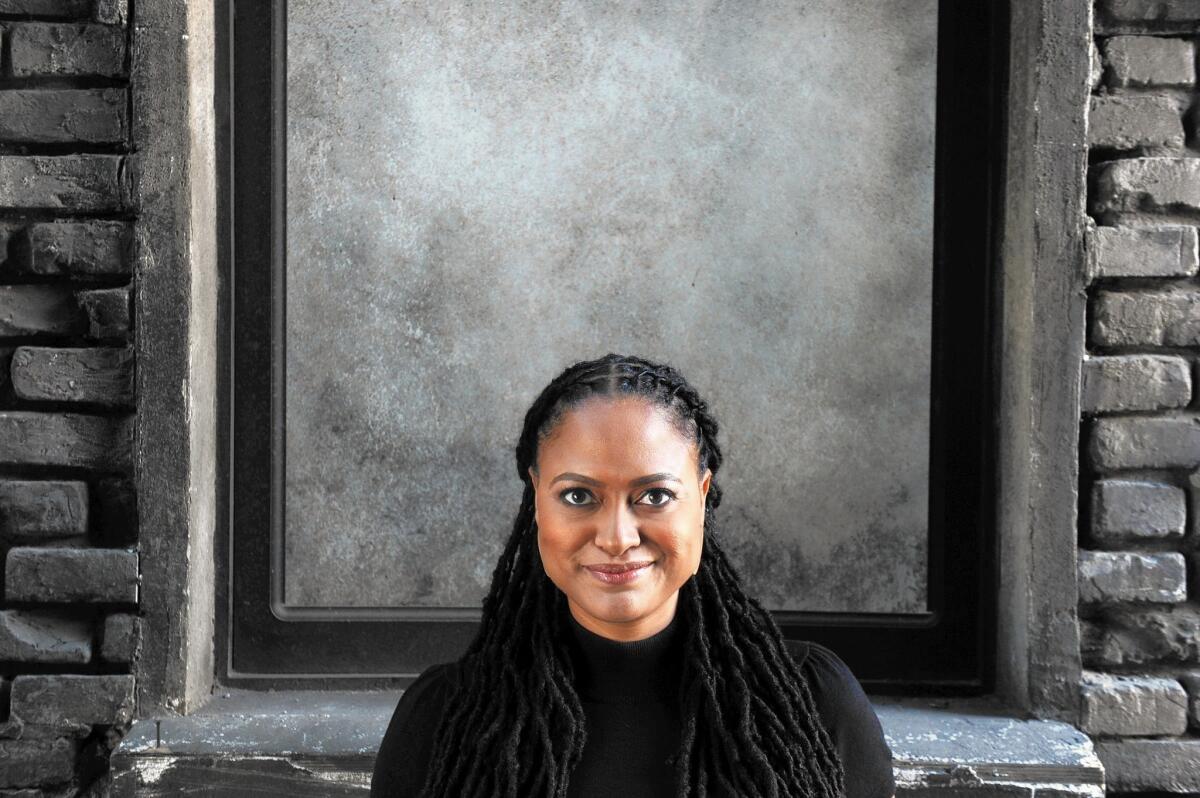Oscars 2015: Female directors scarce at Hollywood’s major studios

When Kathryn Bigelow became the first woman to win the Academy Award for directing in 2010, it looked to be a watershed moment for Hollywood’s premiere creative profession.
But on this Oscar Sunday, all of the directing nominees will be men. No woman has been nominated for directing since Bigelow took home the award for “The Hurt Locker,” which also won best picture.
“I don’t understand why there aren’t more powerful female directors,” said Sam Taylor-Johnson, the woman who directed Hollywood’s latest hit, “Fifty Shades of Grey.” “I don’t have the answers, but I hope that things may start to shift and that studios will employ more women to handle strong and interesting material. Hollywood historically has been a boys club, but hopefully now it’s become co-ed.”
FULL COVERAGE: Oscars 2015 | Complete list of Oscar nominees
The number of major studio films directed by women has been stubbornly low over the last five years, hitting a high of 8.1% in 2010 and falling to a low of 4.6% last year, according to a Times analysis of films directed by women at the six major studios, based on data compiled by IMDB and confirmed with the studios.
Studio executives say the committee-driven process for greenlighting films is a key factor in the low numbers of female directors who get hired. As studios weigh such issues as a movie star’s shortlist of approved filmmakers, a director’s prior box office track record and, increasingly, directors’ experience on big-budget, visual-effects-driven films, the pool of talent becomes smaller.
The Times analysis shows that the studio with the highest percentage of films directed by women between 2009 and 2014 — Sony Pictures Entertainment, at 8.7% — was boosted by its specialty division, Sony Pictures Classics, which distributes lower-budget and foreign films. The studio with the lowest percentage — Warner Bros at 2.3% — relies heavily on big-budget superhero and action films, the genres least likely to be helmed by a woman.
At four other major studios, Universal Pictures had 7.5% of its films directed by a woman, followed by Twentieth Century Fox (7.1%), Walt Disney Studios (6.1%), and Paramount Pictures (4.7%).
Women have experienced success at the box office lately: Taylor-Johnson’s “Fifty Shades of Grey” collected $85 million for Universal in its opening weekend this month, the largest debut ever for a female director; Angelina Jolie’s World War II drama, “Unbroken,” also from Universal, has grossed more than $115 million since its December release; and Ava DuVernay’s “Selma,” from Paramount, has earned nearly $50 million and is nominated for two Oscars, including best picture.
The major studios say they want to hire more women as directors, but they are also devoting more of their resources to fewer movies with higher budgets. That favors $100-million-plus comic book and visual-effects-driven films over the comedies and dramas that have more often provided the few directing slots taken by women.
OSCARS 2015: Ballot | Cheat Sheet | Top nominees |Presenters | Timeline
The challenge on studio films is to find someone who has directed a movie of a similar size, scope and scale before,” said Peter Cramer, co-president of production at Universal Pictures, which has recently stepped up its hiring of female directors under Chairman Donna Langley.
In addition to Taylor-Johnson and Jolie, the studio hired Elizabeth Banks for the comedy sequel “Pitch Perfect 2,” due in May, and Sofia Coppola for a live-action adaptation of “The Little Mermaid.”
Women are better represented in the lower-risk stepping stones to studio film — independent cinema and television — though neither approaches parity.
At this year’s Sundance Film Festival, the preeminent venue for independent films, 36% of the movies were directed by women. In episodic television, where directors play a secondary role to writers and producers creatively, and where budgets are lower, women make up 18% of the first-time directors, according to a study the Directors Guild of America released in January.
“The main reason women can make inroads in independent film is that no one has to say, ‘I pick you,’” said Lynn Shelton, director of six independent features, as well as episodes of “Mad Men,” “The Mindy Project” and “Fresh Off the Boat.” “You can buy a camera for $1,500. It’s insane how easy it is to make an independent movie. You’re not dependent on other people allowing you to do it.”
The studio specialty divisions that draw from the independent film world have a better track record than the industry overall — 12.3% of specialty division Fox Searchlight’s films released over the last six years had female directors, including Amma Asante’s “Belle,” Nicole Holofcener’s “Enough Said” and Drew Barrymore’s “Whip It.”
“We feel it’s important to support female directors because it’s important to see women’s points of view on screen,” said Fox Searchlight President Nancy Utley. “We don’t just want a ‘his’ perspective on the screen, we want a ‘her’ perspective as well.”
A century ago, that was the case — women worked steadily as film directors in the silent era. In 1916, a Pennsylvania-born theater actress named Lois Weber became Universal Pictures’ highest paid director — and later the first woman to open her own studio.
“The culture of film was very open,” said Karen Mahar, a Siena College history professor and author of “Women Filmmakers in Early Hollywood.” “It looked like a modern industry that was going to be 50-50.”
That changed after Hollywood became big business in the 1920s, she said, and the banks that financed movies didn’t want to put increasingly large budgets and crews in female hands.
“If you’re going to risk millions of dollars, you’re going to put a man in charge of that,” Mahar said. “Risk is considered a masculine activity. There were also worries about, ‘Oh, women filmmakers, they’re not going to be tough enough. Can a woman control that many people?’”
Between 1941 and 1980, less than half of 1% of film and television directing work went to women, according to the Directors Guild of America. In 1979, six women formed the DGA Women’s Steering Committee, compiling this data and advocating for more hiring of women across the industry.
Their research inspired the DGA to sue Warner Bros. and Columbia Pictures in 1983 on behalf of its female and minority members; a judge dismissed the suit in 1985 after the studios argued that the DGA contract gives directors the right to select their own assistants, limiting the studios’ liability for discrimination.
PHOTOS: Oscars 2015 top nominees | Presenters
The few women who did direct film and TV in the 1970s and ‘80s describe a hostile work environment, with male crew members deliberately tripping women with cables, and producers referring to female directors as “girls.” Some low-ranking male camera assistants earned more money than female directors.
“This was a community of a hundred guys who had never had a woman leading them, and who didn’t want to have a woman leading them,” said Nell Cox, a director of TV shows such as “M*A*S*H” and “L.A. Law” who was one of the founders of the DGA Women’s Steering Committee. “I went to the trailer where the hair and wardrobe departments were because it was the only other place on the set where there were some women. ... I needed to escape the harshness.”
There have been recent efforts to raise the numbers of female directors.
Last year, Twentieth Century Fox launched its Global Directors Initiative, sending 20 women through a six-week lab that introduced them to senior executives and financing short films.
“People have talked about shadowing programs and mentoring programs for a while, but the numbers are flat, so something is not clicking,” said Nicole Bernard, Fox’s executive vice president for audience strategy. “It’s an antiquated approach to diversity. We’ve been reframing the discussion so it doesn’t feel like, ‘We’ll do this cause it’s the right thing to do.’ No, we’ll do this cause it’s the smart thing to do.”
In 2013, a fund called Gamechanger Films launched to finance female-directed films; its first movie, a low-budget comedy called “Land Ho!,” won an Independent Spirit Award.
But the highest hurdle for women continues to be franchise studio films.
“Women just aren’t moving into the higher-budgeted, top-grossing fare,” said Stacy L. Smith, an associate professor at USC who has studied the issue for the school’s Media, Diversity, & Social Change Initiative. “The No. 1 barrier is financial. Women are perceived to lack confidence and to be less trustworthy with resources.”
For women like “Fifty Shades of Grey” director Taylor-Johnson, forging a career has meant refusing to accept some pervasive biases. When she raised her hand to direct her first film, the 2009 John Lennon biopic “Nowhere Boy,” producers told her they had something else in mind, she said.
“They were dangerously frank to me in saying, ‘We’d prefer a male director,’” she said. Irked, Taylor-Johnson emailed the producers a line of Lennon’s about gender politics. “I said, ‘Remember, John Lennon said this, and so I think you should employ me.”
She got the job.
Twitter: @ThatRebecca
Haley Goldberg and Times staff writer Saba Hamedy contributed to this report.
More to Read
Only good movies
Get the Indie Focus newsletter, Mark Olsen's weekly guide to the world of cinema.
You may occasionally receive promotional content from the Los Angeles Times.











